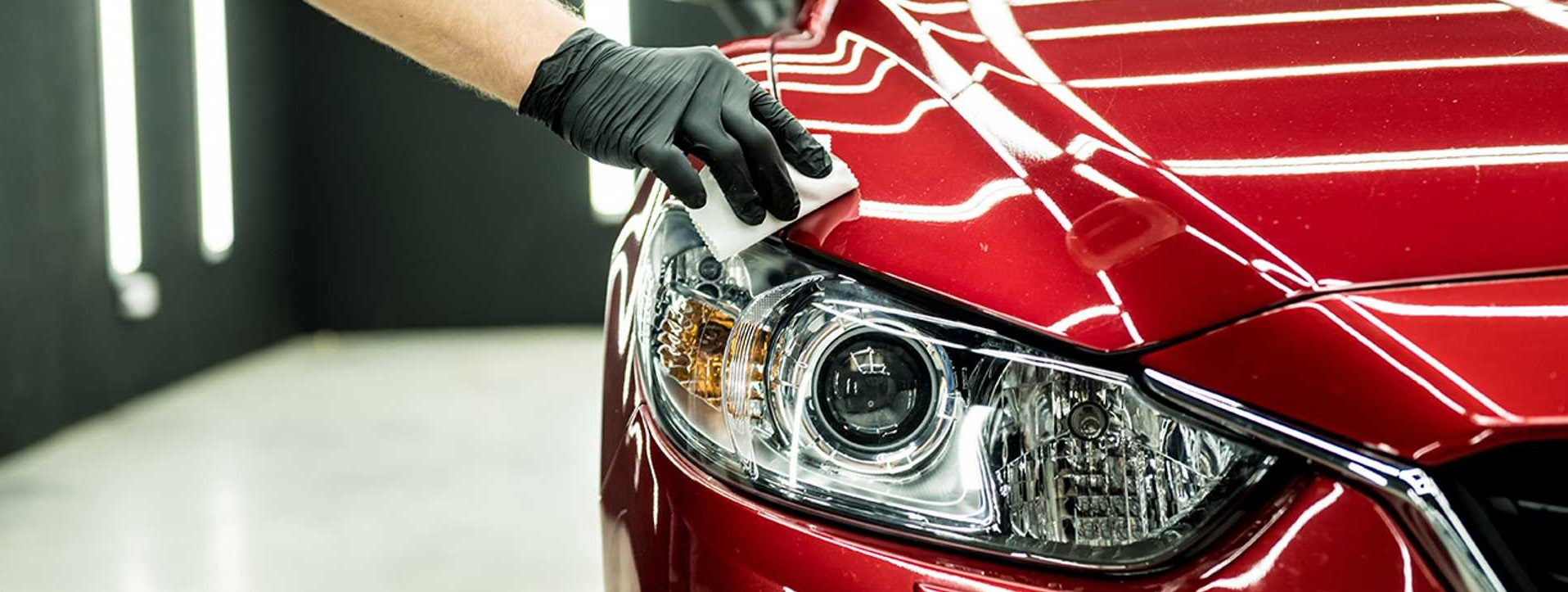Discovering the Science Behind Car Ceramic Coating and Its Protective Residences
The scientific research of car ceramic coating presents a fascinating research study in innovative vehicle defense. Made up primarily of silicon dioxide and polymers, these coatings create a robust bond with lorry paint. This communication boosts durability versus environmental hazards while using hydrophobic benefits. The complexities of exactly how these finishings work and their long-term benefits continue to be much less comprehended. Ceramic Coating Newark. Unpacking these details reveals why ceramic coverings are coming to be a recommended selection for automobile care
What Is Ceramic Coating?
Ceramic coating is a liquid polymer that chemically bonds to the surface of an automobile's paint. This sophisticated protective layer enhances durability and supplies exceptional resistance to environmental variables. Unlike traditional wax or sealants, which supply momentary security, ceramic coverings create a resilient guard that can stand up to harsh problems such as UV rays, acidic impurities, and extreme weather condition. When used appropriately, the coating forms a hydrophobic surface area, causing water to grain and slide off, which assists in maintaining the automobile's tidiness. In addition, it provides improved gloss and deepness to the paint, making the lorry appear even more polished and vivid. The application process generally includes complete surface preparation, including cleansing and polishing, to ensure peak bonding. Consequently, ceramic finishes are becoming increasingly preferred among car lovers and those looking for to safeguard their financial investments, guaranteeing to maintain the automobile's aesthetic charm while minimizing the frequency of maintenance.
The Composition of Ceramic Coatings
The elaborate formulation of ceramic coverings mainly includes silicon dioxide (SiO2), which is derived from all-natural resources like quartz and sand. This crucial element offers the foundation for the coating's resilience and safety high qualities. In enhancement to SiO2, ceramic layers usually consist of various polymers and ingredients that enhance bond, flexibility, and resistance to environmental elements. These compounds function synergistically to produce a durable obstacle against contaminants such as dirt, chemicals, and UV rays.Furthermore, some formulas integrate titanium dioxide (TiO2) or various other nanomaterials, which can increase the coating's hydrophobic properties, resulting in improved water repellency. The accurate composition can vary substantially amongst suppliers, influencing efficiency and long life. Ultimately, the combination of these aspects culminates in a protective layer that not only enhances the aesthetic appeal of vehicles however additionally offers to extend their life expectancy by shielding the surface from prospective damage.
How Ceramic Coatings Work
Recognizing how ceramic coatings work entails exploring their chemical make-up, which adds to their safety top qualities. The application process is crucial for accomplishing ideal outcomes, while long life and toughness aspects identify the coating's effectiveness in time. Together, these components highlight the advantages and performance of ceramic coatings for lorry defense.
Chemical Structure Explained
While numerous car proprietors look for long-lasting defense for their automobiles, the chemical structure of ceramic finishings plays a vital role in their performance. These finishes mainly contain silicon dioxide (SiO2), which is acquired from all-natural minerals. This compound forms a strong bond with the car's paint, producing a sturdy, protective layer. Additionally, numerous ceramic coatings consist of titanium dioxide (TiO2), enhancing their hydrophobic buildings and resistance to UV rays. The visibility of polysiloxanes can even more boost flexibility and resilience. Together, these elements contribute to the coating's ability to ward off water, dust, and contaminants, while likewise giving a high-gloss finish. Recognizing this chemical structure aids car owners appreciate the robust defense supplied by ceramic finishings.
Application Refine Summary
Applying ceramic coverings includes a thorough process that guarantees ideal bonding and security for the automobile's surface area. Initially, comprehensive cleansing and purification of the car's exterior are performed to remove dust, crud, and previous waxes. This step confirms that the surface is devoid of impurities that could hinder adhesion. Following this, the paint is commonly brightened to boost Learn More Here quality and get rid of any kind of blemishes. Once prepared, the ceramic coating is applied in little areas making use of an applicator pad, permitting consistent insurance coverage. The coating is after that left to heal, developing a solid chemical bond with the surface. Proper curing times and conditions are vital, as they confirm the coating achieves its maximum effectiveness and safety top qualities.
Long Life and Resilience Elements
Ceramic finishings are developed to offer lasting protection through their advanced chemical composition, which develops a durable barrier against environmental impurities. The durability of these layers is affected by elements such as the density of the application, the top quality of the item, and the conditions under which the automobile is exposed. Premium ceramic coatings can last several years, standing up to scratches, UV rays, and chemical stains. Appropriate upkeep, consisting of normal washing and periodic reapplication, can additionally boost long life. Additionally, environmental elements like environment and direct exposure to contaminants can impact the life expectancy of the coating. Overall, when used and maintained appropriately, ceramic coverings offer exceptional toughness, making them a popular selection for car enthusiasts seeking to protect their vehicle's appearance.
Hydrophobic Characteristics and Water Repellency
Hydrophobic homes are a characteristic of quality car ceramic layers, substantially boosting the car's surface area efficiency. These coverings create a molecular bond with the car's paint, leading to a surface area that drives away water effectively. When water enters contact with a ceramic-coated surface, it beads up and rolls off, decreasing the quantity of liquid see this website that stays on the paint. This behavior not just adds to a cosmetically pleasing appearance but likewise decreases the build-up of impurities such as dirt, crud, and road salts.The boosted water repellency leads to much easier cleaning and maintenance, as less effort is required to remove unwanted substances. On top of that, the hydrophobic nature of ceramic finishes assists in stopping water areas, which can mar the coating of uncoated surface areas. Generally, the incorporation of hydrophobic homes in ceramic coverings plays a necessary duty in preserving the automobile's pristine appearance while streamlining maintenance.
Security Versus Scratches and UV Damage
Car ceramic finishings supply considerable protection versus scratches and UV damage. The scrape resistance device creates a durable layer that absorbs influences, while the UV securing benefits aid maintain the automobile's paint honesty over time. With each other, these attributes contribute to a longer-lasting and visually attractive coating.
Damage Resistance Mechanism
Making use of advanced innovation, ceramic coverings offer a robust shield versus scrapes and UV damages, boosting the durability and appearance of vehicle surfaces. The scrape resistance mechanism of these layers is credited to their special molecular structure, which develops a resilient bond with the vehicle's paint. This bond develops a hard, safety layer that can absorb impacts and stand up to abrasions. Furthermore, the smooth surface of the coating lowers friction, making it challenging for contaminants to adhere and trigger scratches. The chemical composition of ceramic coatings often consists of nanoparticles that reinforce the protective layer, more boosting its durability. Cars treated with ceramic finishings display markedly enhanced scratch resistance compared to typical wax or sealants, ensuring an excellent coating over time.
UV Protecting Benefits
The safety high qualities of ceramic layers prolong beyond scrape resistance to include considerable UV protecting advantages. These finishings develop a robust barrier that shows unsafe ultraviolet rays, securing the lorry's paint and underlying materials. Long term direct exposure to UV radiation can result in fading, oxidation, and degeneration of the paint finish. By incorporating ceramic finishings, car proprietors can properly minimize these threats, maintaining the visual allure and honesty of their vehicles. In addition, the UV blocking residential properties add to enhanced durability, decreasing the frequency of repainting and maintenance. Inevitably, the assimilation of ceramic layers provides a comprehensive remedy for safeguarding vehicles from the damaging effects of sun exposure, guaranteeing a sustained, vibrant appearance in time.
The Long life and Maintenance of Ceramic Coatings

Frequently Asked Inquiries
Can Porcelain Coating Be Applied to Any Kind Of Lorry?
Ceramic coating can be put on numerous kinds of automobiles, including cars and trucks, vehicles, and bikes. However, surface area prep work and compatibility with particular materials are important for excellent bond and effectiveness of the coating.
Exactly How Much Does Ceramic Coating Commonly Price?
Ceramic coating commonly sets you back in between $500 and $2,000, depending upon elements such as vehicle size, coating high quality, and professional application. The investment can provide resilient security and improve the automobile's look over time.

Is Expert Application Needed for Finest Results?
The need of specialist application frequently relies on wanted outcomes. Specialists usually assure proper surface prep work and application techniques, leading to suitable bonding and long life of the coating, which may be testing for unskilled individuals to achieve.
Can Porcelain Coatings Be Eliminated or Fixed?
Ceramic coatings can be gotten rid of or fixed, though the process may need details solvents or methods - Ceramic Coating Newark. Proper removal is important to avoid damages to the underlying surface area, highlighting the importance of expert help for optimal results
Just How Does Porcelain Coating Contrast to Standard Wax?
The contrast between ceramic coating and typical wax exposes that ceramic finishings supply superior resilience, enhanced protection versus environmental contaminants, and longer-lasting luster, while wax requires more constant application and offers much less overall resistance to damages.